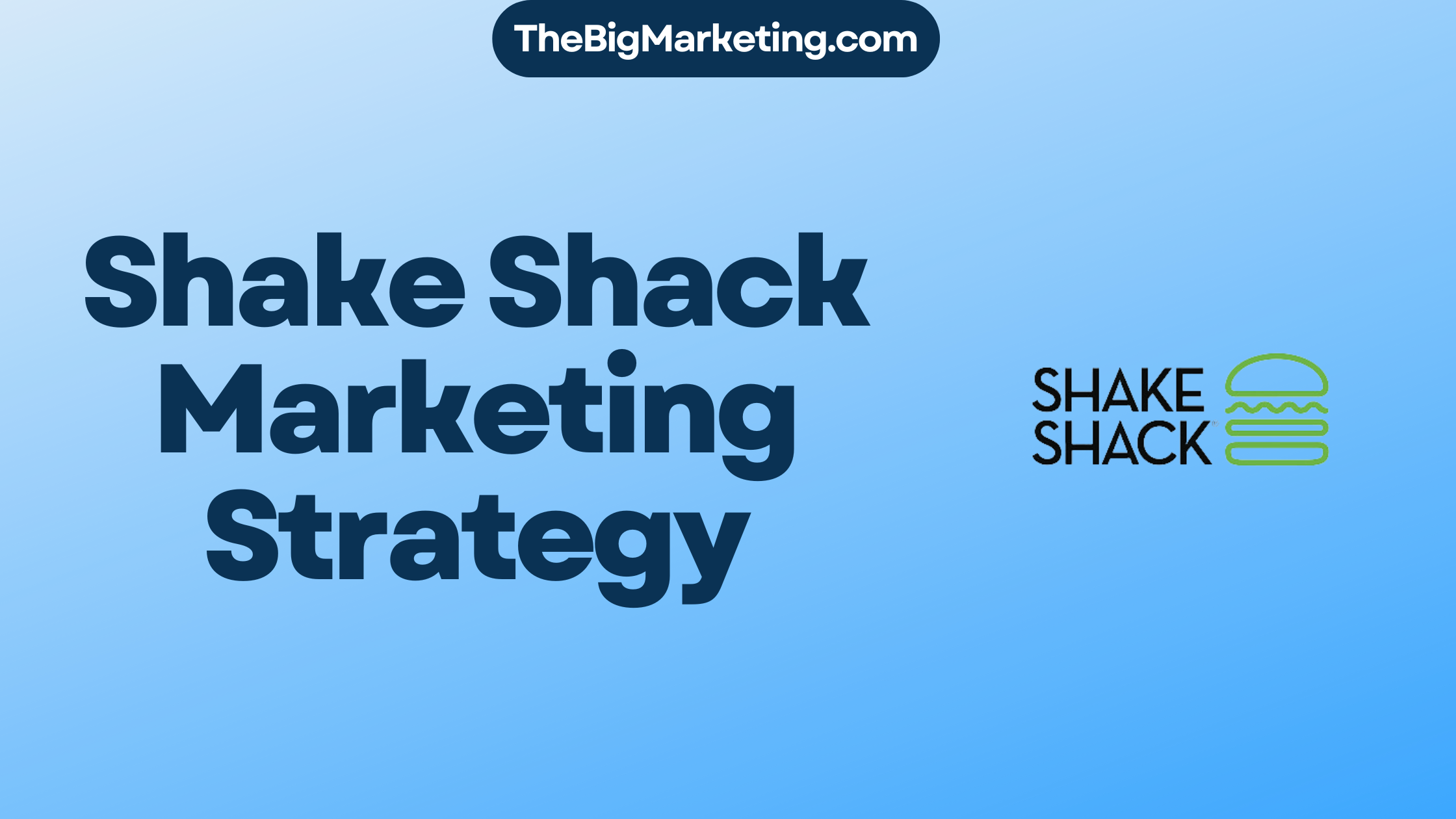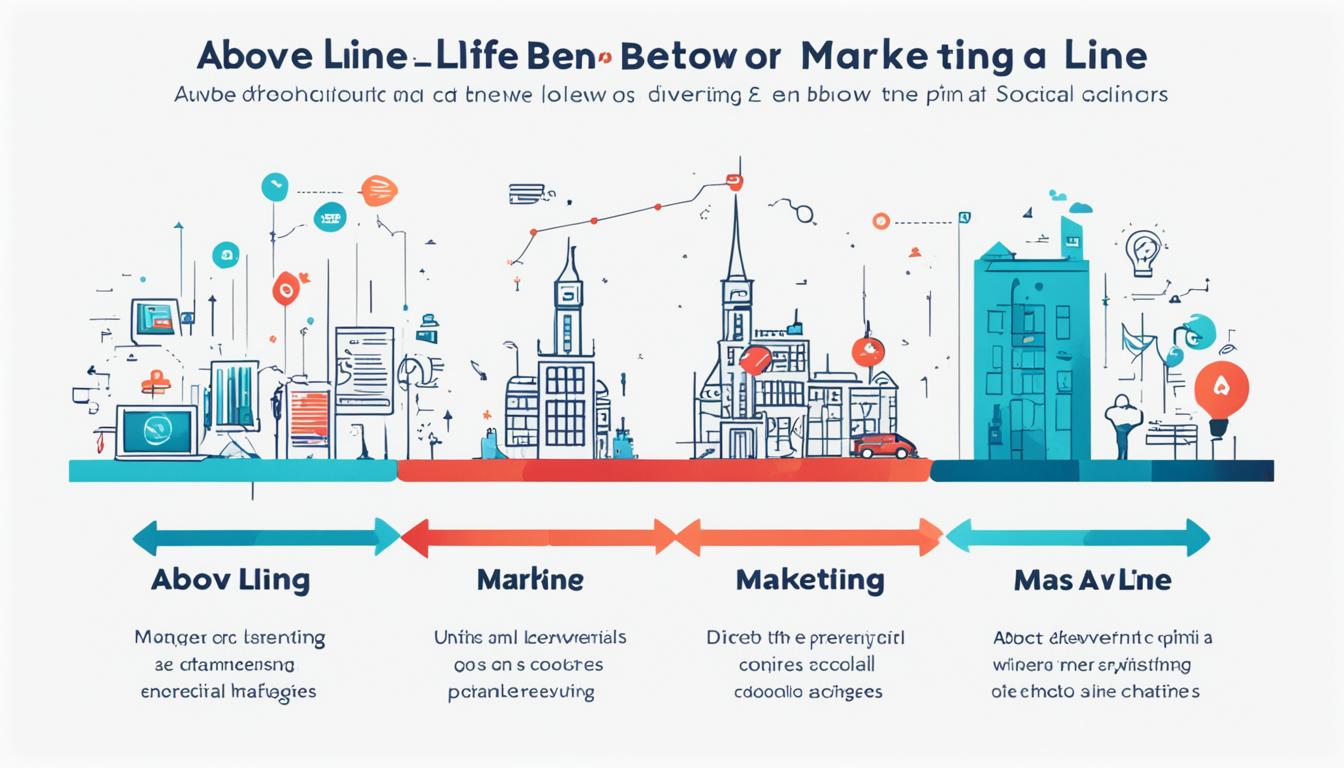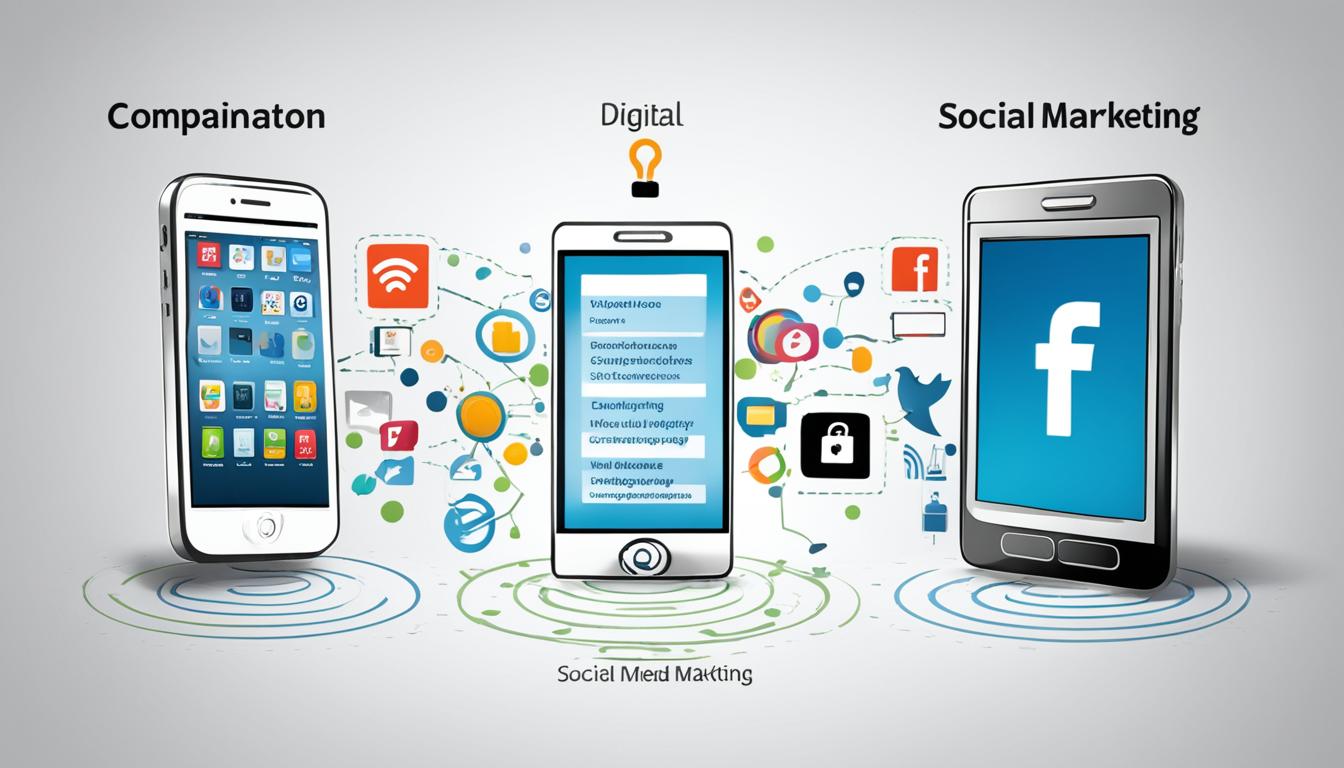In 2006, Hitachi Ltd. embarked on a new corporate strategy centered around social innovation and long-term growth. This strategic shift aimed to align its diverse business units and make a meaningful contribution to addressing global challenges. Through collaboration with BSR, Hitachi developed a comprehensive marketing strategy that prioritized stakeholder concerns and focused on critical social and environmental needs.
Key Takeaways:
- Hitachi’s marketing strategy emphasizes social innovation and long-term growth.
- The strategy aligns business units and addresses global challenges.
- Collaboration with BSR helped prioritize stakeholder concerns.
- Marketing tactics focus on critical social and environmental needs.
- The strategy aims to drive business success alongside societal impact.
Aligning Management and Stakeholder Engagement
BSR worked closely with Hitachi to assess key priorities in corporate responsibility and social innovation. By employing the materiality principle, Hitachi conducted a comprehensive analysis of the most significant risks and opportunities across all business units and geographic regions. This competitive analysis allowed Hitachi to gain valuable insights into the market landscape and identify strategic areas for growth and development.
Furthermore, Hitachi recognized the importance of engaging stakeholders in their decision-making processes. To ensure inclusivity and gather input on addressing social and environmental challenges, Hitachi organized two events in New York and Brussels. These events provided a platform for stakeholders to voice their expectations and fostered valuable dialogue between Hitachi and its diverse stakeholder groups.
Hitachi Target Market Analysis and Promotional Campaigns
Through the Hitachi competitive analysis, the company gained a deeper understanding of its target market and the factors that drive consumer behavior. This analysis helped Hitachi refine its marketing tactics and develop targeted promotional campaigns that resonated with its audience.
| Target Market Analysis | Promotional Campaigns |
|---|---|
|
|
By leveraging the insights gained from the Hitachi target market analysis, the company was able to tailor its promotional campaigns for maximum impact and effectiveness. This approach ensured that Hitachi’s marketing efforts were targeted, relevant, and resonated with its desired customer segments.
Focus on Social Innovation Businesses
Hitachi’s global CSR strategy plays a pivotal role in guiding key investment decisions, enabling the company to focus on social innovation businesses. By aligning with societal needs, Hitachi strategically invests in information and communications systems, social infrastructure systems, and smart-grid technology. This targeted approach allows Hitachi to create products and services that address the most pressing challenges faced by society and contribute to sustainable development.
One of the key pillars of Hitachi’s branding strategy is to position itself as a leader in social innovation. By deploying its resources and expertise in these specific areas, Hitachi aims to make a tangible difference in areas such as green mobility and new energy production. Such focused innovation ensures that Hitachi’s offerings are closely aligned with market demands, creating value for both the company and its customers.
Market Segmentation for Targeted Impact
Market segmentation is a critical component of Hitachi’s market strategy. By dividing the market into distinct segments based on shared characteristics, Hitachi can tailor its products, services, and marketing efforts to the specific needs and preferences of each segment. This approach allows Hitachi to maximize its marketing impact by communicating directly with the relevant target audience.
A comprehensive market segmentation analysis helps Hitachi gain insights into customer behaviors, preferences, and purchasing patterns. By understanding the unique requirements of different customer segments, Hitachi can refine its offerings and develop targeted promotional campaigns that resonate with each segment’s needs. This targeted marketing approach enhances Hitachi’s brand positioning and increases its competitiveness in the market.
Hitachi’s commitment to social innovation, combined with market segmentation practices, enables the company to create a strong foothold in the industry. By aligning its business strategy with societal needs and closely understanding its target markets, Hitachi aims to drive sustainable growth while making a positive impact on the world.
Exploring Market Segments
Hitachi has identified several market segments as part of its market segmentation strategy:
| Market Segment | Description |
|---|---|
| Information and Communications Systems | Offering cutting-edge technologies and solutions that enable efficient communication and data management |
| Social Infrastructure Systems | Providing innovative solutions for urban development, transportation, and other critical societal infrastructure |
| Smart-Grid Technology | Developing advanced energy management systems to optimize energy distribution and consumption |
Each market segment represents a unique opportunity for Hitachi to address specific societal challenges and contribute to social innovation. With its expertise and focus on these areas, Hitachi can develop solutions that drive positive change and deliver sustainable value to its customers.
Through its branding strategy and market segmentation approach, Hitachi is able to position itself as a market leader in social innovation and create a positive impact on the world. By investing in key areas of social innovation and understanding the diverse needs of its target markets, Hitachi remains at the forefront of developing innovative solutions that address society’s biggest challenges.
AI Empowers, Gets Real: Infused with Trust and Explainability
The use of Generative AI, such as ChatGPT, has gained significant attention and investment in the world of digital marketing. AI-powered applications have the potential to revolutionize decision-making processes and enhance marketing strategies. However, there is a challenge in trusting AI for critical decision-making due to the lack of context and expertise in current AI models.
To harness the true power of AI in digital marketing, it is crucial to ground AI applications with specific context and data. This ensures that the results provided by AI are accurate, explainable, and most importantly, trustworthy. By infusing AI with trust and explainability, businesses can leverage its capabilities to improve marketing efforts and gain a competitive edge.
Enhancing the Hitachi Digital Marketing Approach
Hitachi has recognized the importance of trust and explainability in their digital marketing approach. They have implemented measures to ensure that their AI-powered marketing campaigns are reliable and transparent. By conducting a comprehensive competitive analysis, Hitachi can evaluate their marketing strategies and identify opportunities to leverage AI effectively.
Hitachi’s competitive analysis involves studying the marketing tactics employed by their competitors in the industry. This analysis provides valuable insights into how Hitachi can differentiate itself and optimize its digital marketing efforts. By understanding the strengths and weaknesses of their competitors, Hitachi can refine their marketing messages and create targeted campaigns that resonate with their audience.
Building Trust with Customers
Trust is a crucial factor in any marketing strategy. Customers need to feel confident in the products or services they choose. By infusing AI with trust and explainability, Hitachi can address customer concerns and build stronger relationships. By providing transparent explanations of how AI algorithms work and how data is processed, Hitachi can demonstrate their commitment to customer satisfaction.
| Benefits of Hitachi’s Digital Marketing Approach | How Hitachi Leverages Competitive Analysis |
|---|---|
|
|
By embracing AI and leveraging insights from competitive analysis, Hitachi can create a digital marketing approach that resonates with its target audience. The combination of trust, transparency, and data-driven decision-making empowers Hitachi to achieve marketing success in an increasingly competitive landscape.
Edge and IoT: Taking the Bite Out of the Data Explosion
The convergence of the physical and digital worlds through IoT (Internet of Things) has revolutionized the way businesses operate. With IoT, an incredible amount of data is generated daily, offering immense opportunities for companies to gain valuable insights and drive growth. However, effectively handling and extracting meaningful information from this data can be challenging.
Enter Edge AI, a powerful combination of edge computing and artificial intelligence. Edge AI enables businesses to process data closer to the source, eliminating the need to transmit all the data to the cloud or a central server. By decentralizing data processing, companies can increase their data intelligence, reduce latency, and enhance security.
Edge AI’s proximity to the source facilitates real-time analysis, enabling businesses to identify trends and patterns rapidly. This immediate access to data-driven insights empowers companies to make data-backed decisions promptly.
Benefits of Edge AI in Digital Marketing
When it comes to digital marketing, Edge AI offers numerous advantages:
- Reduced Latency: By processing data locally, Edge AI minimizes delays in data analysis, allowing businesses to respond faster to consumer needs and preferences.
- Improved Personalization: With real-time analysis capabilities, companies can deliver highly targeted and personalized marketing messages to their customers, enhancing the customer experience.
- Enhanced Data Security: Edge AI allows for data processing and analysis to happen at the device or edge level, reducing the risk of sensitive data being compromised during transmission to centralized servers.
- Cost Optimization: By processing and filtering data at the edge, businesses can reduce the amount of data sent to the cloud or central servers, optimizing storage and network costs.
Unlocking the Value of IoT Data with Edge AI
Implementing Edge AI in conjunction with IoT can unlock the full potential of the data explosion businesses face. By harnessing the power of Edge AI, companies can:
- Perform real-time monitoring and analysis of IoT data streams
- Identify anomalies and patterns in sensor data for predictive maintenance
- Enable faster decision-making based on intelligent insights
- Improve operational efficiency and resource allocation
- Enhance product and service offerings through data-driven innovation
The integration of IoT and Edge AI enables businesses to leverage the data generated by connected devices and sensors, transforming it into valuable knowledge and actionable insights.
By leveraging Hitachi’s expertise in IoT and Edge AI, companies can stay ahead of the competition in the ever-evolving digital landscape. Hitachi’s marketing tactics and digital marketing approach can help businesses unlock the full potential of their IoT data, driving growth and success.
| Advantages of Edge AI in Digital Marketing | Benefits of Edge AI in Digital Marketing |
|---|---|
| Reduced Latency | Offer real-time responses to consumer needs |
| Improved Personalization | Deliver highly targeted and personalized marketing messages |
| Enhanced Data Security | Minimize the risk of sensitive data compromise |
| Cost Optimization | Optimize storage and network costs |
The Cloud Grows Up: From Cloud-First to Cloud-Smart
While the cloud was once seen as the ultimate solution for IT needs, companies are now realizing the importance of a hybrid cloud approach. This balancing act between public cloud, on-premise, and co-location environments addresses concerns such as data transfer fees, security, data sovereignty, and performance. A hybrid cloud foundation enables robust data management, supporting more effective use of AI and digital infrastructure investments.
With the rapid evolution of technology and the increasing demand for efficient and secure data management, Hitachi recognizes the need to go beyond a traditional cloud-first approach. A cloud-smart strategy allows businesses to leverage the benefits of both public and private cloud environments while ensuring optimal performance and cost-effectiveness.
Benefits of a Hybrid Cloud Approach
- Flexibility: A hybrid cloud model provides the flexibility to choose the most suitable environment for each workload, whether it’s public cloud, on-premise infrastructure, or a combination of both.
- Cost Optimization: By strategically allocating workloads across different cloud environments, companies can optimize costs based on specific requirements and usage patterns.
- Data Sovereignty: In certain industries with strict data regulations, a hybrid cloud approach allows organizations to keep sensitive data on-premise or in a private cloud while leveraging the scalability and cost benefits of public cloud services for non-sensitive workloads.
- Security and Compliance: A hybrid cloud architecture allows businesses to tailor security measures and compliance frameworks to meet specific requirements, ensuring data protection and regulatory compliance.
- Performance: By distributing workloads across various environments, organizations can optimize performance by leveraging the strengths of each platform, reducing latency, and improving user experience.
Adopting a cloud-smart approach requires a well-defined marketing plan that takes into account the unique needs and market segmentation of the organization. Hitachi’s marketing strategy focuses on understanding customers’ cloud requirements, identifying key pain points, and offering tailored solutions that leverage the advantages of hybrid cloud deployments. By effectively segmenting the market and targeting different customer segments with customized messaging, Hitachi can position itself as a leader in the cloud-smart era.
Cyber Resilience Requires Business Transformation
In today’s rapidly evolving threat landscape, cyber resilience is a critical priority for businesses. It goes beyond simply preventing data breaches; it involves adopting a comprehensive approach to security and recovery. The increasing frequency and sophistication of cyber attacks, such as ransomware, highlight the urgent need for organizations to rethink their strategies and incorporate both technology and business considerations.
To maintain business continuity and mitigate the growing risks of data theft and extortion, tech leaders must proactively implement measures that address the complex nature of cyber threats. This requires a holistic approach that encompasses not only technical safeguards but also robust incident response plans, employee training, and continuous monitoring.
Recognizing the Need for Transformation
The ever-changing cybersecurity landscape necessitates a fundamental shift in business practices. Organizations must acknowledge that cyber resilience is not a one-time project, but an ongoing process that demands constant improvement and adaptation. By embracing a transformative mindset, businesses can stay ahead of emerging threats and protect their valuable assets.
A key aspect of this transformation lies in conducting a thorough competitive analysis. By understanding the evolving tactics and techniques employed by cybercriminals, organizations can identify vulnerabilities and develop effective countermeasures. This analysis should encompass not only technical aspects but also the broader digital marketing approach, ensuring that security measures align with the organization’s overall business objectives.
Embracing a Digital Marketing Approach to Cyber Resilience
Hitachi recognizes that cyber resilience is not solely a technical concern but also a critical component of their digital marketing strategy. By integrating cybersecurity considerations into their overall marketing plan, Hitachi ensures that their products and services are not only innovative but also built with security in mind.
Hitachi’s digital marketing approach incorporates advanced technologies such as AI and machine learning to detect and respond to potential cyber threats. They leverage data analytics to identify patterns and anomalies that could indicate a security breach, allowing for immediate action to be taken.
Moreover, Hitachi recognizes the importance of proactive communication with customers and stakeholders regarding its cybersecurity measures. By transparently communicating their commitment to cyber resilience, Hitachi builds trust and confidence in their brand, setting themselves apart from competitors.
Moments Planning for Effective Campaign Integration
To ensure the success of their promotional campaigns and effectively target their diverse customer base, Hitachi implemented a Moments Planning tool. This strategic approach allowed them to gain valuable insights into their target audience, including their media preferences and motivations. By understanding these critical factors, Hitachi was able to create integrated campaigns across multiple channels, guaranteeing consistency and delivering high-quality messaging to their audience, irrespective of location.
This data-driven approach empowered Hitachi to segment their market effectively, tailoring their campaigns to specific customer segments. By identifying and understanding the unique needs and preferences of different customer groups, Hitachi was able to deliver personalized and relevant messaging that resonated with their audience. This targeted approach significantly enhanced the effectiveness of their promotional campaigns, resulting in increased brand awareness, customer engagement, and ultimately, business growth.
Enhancing Customer Engagement Through Comprehensive Data Analysis
With the help of Moments Planning, Hitachi conducted in-depth market segmentation analysis, considering various demographic and psychographic factors. By leveraging advanced data analysis techniques, Hitachi gained valuable insights into consumer behavior, preferences, and buying patterns, enabling them to develop highly targeted promotional campaigns.
Through this comprehensive analysis, Hitachi identified specific customer segments that were most likely to respond positively to their campaigns. Understanding the unique needs and motivations of these segments allowed Hitachi to create compelling and personalized campaigns that spoke directly to their audience, maximizing customer engagement and driving desired actions.
Future Trends and Opportunities
Tech leaders in 2024 need to continuously learn and adapt as the landscape evolves. To gain competitive advantages, Hitachi employs various marketing tactics, a digital marketing approach, a branding strategy, and market segmentation. Embracing AI is crucial for driving innovation and differentiation. By leveraging AI technologies, businesses can enhance customer experiences, optimize operations, and develop personalized marketing campaigns. Hitachi’s digital marketing approach focuses on utilizing data-driven insights to target specific customer segments effectively.
Another trend is the rise of edge computing, which enables real-time data processing and analysis at the network’s edge. This approach reduces latency and improves the efficiency of IoT devices. Hitachi incorporates edge computing into its marketing tactics, enabling targeted and personalized messaging based on real-time data insights.
Hybrid Cloud: The Perfect Balance
Hitachi understands the importance of a hybrid cloud approach in today’s digital landscape. By combining public cloud, on-premise, and co-location environments, businesses can address concerns such as data transfer fees, security, data sovereignty, and performance. Hitachi’s marketing strategy involves guiding businesses through their cloud transformation journey, helping them optimize their infrastructure and leverage the power of the cloud to drive growth.
Cyber Resilience for Business Continuity
With the increasing cybersecurity threats, Hitachi recognizes the need for a comprehensive cyber resilience strategy. Cyber resilience goes beyond mere prevention and involves the ability to recover quickly from an attack while ensuring continuity of business operations. Hitachi’s marketing approach emphasizes the importance of integrating security measures at every level of the organization, including people, processes, and technologies.
Furthermore, Hitachi understands the significance of effective campaign integration to maximize reach and impact. By leveraging market segmentation methodologies, Hitachi tailors its marketing campaigns to specific target audiences. This approach ensures that the right message reaches the right customers via the most appropriate channels.
Predictive Analytics and Market Segmentation
Market segmentation is a key aspect of Hitachi’s branding strategy. By analyzing customer data, preferences, and behaviors, Hitachi segments its target market to deliver personalized experiences and meet specific customer needs. Leveraging predictive analytics, Hitachi can anticipate customer trends and preferences, enabling proactive marketing campaigns that drive customer engagement and loyalty.
| Segment | Key Characteristics |
|---|---|
| Enterprise | Large organizations with complex IT needs, seeking comprehensive solutions. |
| SMB | Small and medium-sized businesses with limited IT resources, looking for scalable and cost-effective solutions. |
| Consumer | Individual consumers seeking innovative and user-friendly products. |
By staying ahead of industry trends and continuously innovating, Hitachi remains at the forefront of technology-driven marketing strategies. As the digital landscape evolves, Hitachi is committed to delivering cutting-edge solutions that empower businesses and drive success in an increasingly competitive market.
Conclusion
Hitachi’s marketing strategy in 2024 is built upon a foundation of social innovation and a commitment to addressing global challenges. Through strategic alignment, Hitachi aims to leverage its diverse business units to contribute to solving critical social and environmental needs while driving long-term growth.
This approach includes embracing advanced technologies such as AI and edge computing to empower decision-making and enhance business operations. By adopting a hybrid cloud approach, Hitachi ensures secure and efficient data management, enabling more effective use of AI and digital infrastructure investments.
In addition, Hitachi recognizes the importance of cyber resilience in today’s threat landscape and integrates comprehensive security measures to protect against data breaches and cyber attacks. Furthermore, Hitachi’s marketing tactics include powerful promotional campaigns that are integrated across multiple channels, ensuring consistent and impactful messaging for the target audience.
With a focus on social innovation, effective campaign integration, and leveraging cutting-edge technologies, Hitachi’s marketing strategy positions the company at the forefront of the industry. By addressing societal and environmental challenges while driving business growth and success, Hitachi remains committed to making a positive impact on the world.








